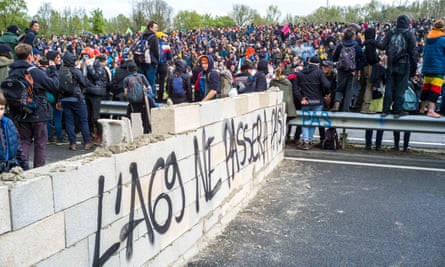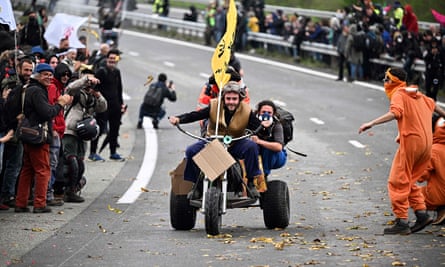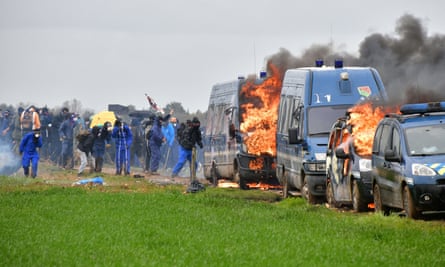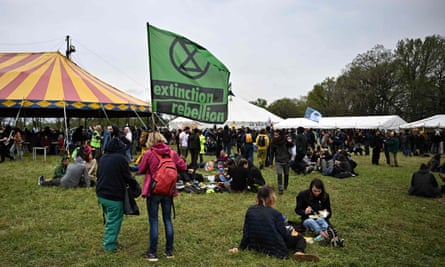WORD NEWS
Hearth and concrete: will France’s mannequin of radical local weather protest catch on? | Environmental activism
In the UK, when local weather activists need to block a highway, they sit down on it. When their fellow activists in France need to do the identical, they construct a wall throughout one facet, and set the opposite facet on fireplace.
As Extinction Riot drew tens of hundreds to their peaceable “Huge One” protests in London final weekend, within the south of France 8,500 environmental protesters occupied the highway from Toulouse to the city of Castres.
In protest at plans for a brand new motorway, which critics say will devastate agricultural land and speed up local weather breakdown, the coalition of natural farmers, environmentalists, communists and anarchists danced to techno and raced soapboxes alongside the carriageway. Then they used breeze blocks and concrete to dam one facet of the carriageway, whereas on the opposite they piled haystacks and tyres and set them ablaze.

Remarkably, they did so with none interruption from police, regardless of perpetrating a degree of unlawful disruption remarkable throughout the Channel.
As local weather protests scorching up all over the world as soon as once more, eyes have been turning to France because the nation taking it to its most radical extent. This month, Andreas Malm, the human ecologist and creator of the local weather activist bible How you can Blow Up a Pipeline, mentioned in an interview it was France that was seeing essentially the most thrilling developments in environmental protest.
However why is it in France that environmental activists are taking essentially the most radical motion?

The battle of Sainte-Soline
Earlier than final weekend’s march, the French protesters gathered at a camp on land offered by a neighborhood dairy farmer whose farm, simply outdoors Castres, can be sliced in two by the brand new A69 motorway. Police had warned them that they may block entry to the location at any second.
Three younger activists with France’s natural farmers’ union the Confédération Paysanne, Mathieu, Victor and Valentin, mentioned there have been fears about how the police would reply to the protest. It was to be the primary main environmental protest since a fierce battle between activists and police in March at a controversial reservoir undertaking in Sainte-Soline.
On 25 March, hundreds of environmental protesters had defied an official ban on protests to assemble at a camp close to the small city, south-west of Poitiers, close to France’s west coast, with many intent on sabotaging the 628,000 sq metre reservoir. They have been met by an enormous police response: 20 squadrons of cell gendarmes, 9 helicopters, 4 armoured automobiles, and 4 water cannon, with officers arranging themselves in defensive formations across the development website.

Subsequent scenes, filmed by journalists and activists, have been shared extensively. Protesters have been seen working in direction of the police traces via volleys of teargas grenades, whereas gendarmes flanked them on quad bikes. Activists fired improvised firework mortars at officers, who responded with baton rounds.
The battle lasted roughly an hour. Mathieu, Victor and Valentin instructed how, after activists had began masking teargas canisters with earth to cease their fumes dispersing, police switched to utilizing flash bang grenades. A number of protesters misplaced fingers because of this, the three activists mentioned, whereas others have been injured after standing on dormant grenades.
By the point it was over, police had, by their very own account, fired greater than 5,000 teargas grenades, greater than 100 stun grenades, and 81 baton rounds. The French inside ministry mentioned 28 gendarmes have been damage, two of them severely. Organisers counted 200 protesters injured within the combating, with one nonetheless in a coma greater than a month later.
Within the following days, there have been dozens of rallies denouncing the police violence at authorities buildings round France. The minister of the inside, Gérald Darmanin, introduced he supposed to ban Les Soulèvements de la Terre (Earth Uprisings), a bunch that had performed a key position in organising the protest.
‘There isn’t any query of working with the police’
Les Soulèvements de la Terre was amongst a lot of organisations that had referred to as the Castres protest final weekend. Darmanin had backed down from his menace to ban the group, however the motorway undertaking was one among 42 which he had claimed in parliament have been “probably to offer rise to extraordinarily violent protests”, together with “towards republican establishments”. In accordance with stories, a contingent of practically 800 gendarmes and CRS riot police was deployed, together with eight cell models.
Because the solar rose over the camp on Saturday morning, the dimensions of the protest might be seen. Tons of of campers had spent the night time in tents subsequent to 2 huge tops decked out with sound methods and furnishings. Marquees housed a kitchen handing out banana porridge and low. Compost bogs have been offered for protesters’ comfort.

A younger activist referred to as Birdie defined that though they supposed the day’s protest to be peaceable, activists in France have been extraordinarily cautious of police – and subsequently of the media. “The French authorities has this doctrine of how they need to cope with protesters, which is violence and weapons and surveillance,” Birdie mentioned.
“And so it signifies that as protesters … we have now to guard ourselves from the federal government. I do know that the police know who I’m. I do know they know who my pals are, who my household is, and they’ll simply seize something to repress me, to place me in jail.”
Birdie mentioned Darmanin referred to as them “terrorists”. “You’ll be able to see this camp: we’re not terrorists. We’re simply individuals who cook dinner, who clear, who put up bogs, who play music, who protest. That is one thing that we do. We’re not violent individuals. However they attempt to make us go as violent individuals and as terrorists. And as such, we have now to watch out what we present and who we present we’re.”
Jean-Luc Herve, an natural farmer and member of Confédération Paysanne, was one of some participating within the Castres protests who would communicate on the file. He defined that the brand new highway would devastate agriculture within the space.
“The demonstration, it’s a protest towards the A69 motorway undertaking,” Herve mentioned. “We [already] have a nationwide highway between Toulouse and Castres. At rush hour, it at present operates at 30% capability so we completely don’t have to construct a motorway subsequent to this nationwide highway as a result of there usually are not sufficient automobiles to make use of it.
after newsletter promotion
“There are a lot of negative impacts. The first impact for us, as farmers of the Confédération Paysanne union, is the artificialisation of the land. Artificialisation means that land that was agricultural land, for food production, for self-sufficiency, food sovereignty in local areas, et cetera, will be lost. And land is not something that can be made. When it is lost, it’s lost forever.”
Herve estimated that once the new road and its attendant infrastructure was established, the region stood to lose 1,000 hectares of good agricultural land, with impacts on 162 species of fauna protected by law in France.
“Then there’s another element which is part of the larger context of the fight or the adaptation to global warming,” he added. “We know very well that we have to abandon the everything-by-car model. These are goals that are set out by government action programmes. Other means of travel must be prioritised. We should give priority to trains, we should give priority to public transport and stop building infrastructure that is designed for the car.”
As the morning wore on, and the time of the march approached, hip-hop and punk music was played from a PA and the crowd gathered around a marquee for speeches. Leftwing MPs stood alongside black-block militants, and black and red anarchosyndicalist flags flew alongside extinction symbols and the banners of communist trade unions.
Many had come, to march the route of the proposed motorway, prepared for a strong police response, with some protesters wearing helmets, shinpads, protective gloves, or even gas masks. Malm said the French approach to protest was unlike any neighbouring country’s.
“France is like no other country in western Europe, in my view, in the sense that it has a living tradition of popular struggle,” he said.
“It’s like France is almost like a volcano … It goes quiet for a while, but then it always has an eruption, sooner or later. And there is a continuous more or less unbroken tradition of people trying to defend their interests and not just sitting by when their lives are wrecked.”
Recently, that popular struggle could be seen against the cost of living crisis, or attacks on workers’ conditions, such as the current hikes to the pension age. “And finally, and I’ve been waiting for this to happen, finally, you see that tradition taking on a clear ecological aspect as well,” Malm said.
On the march, members of France’s own chapter of XR, a group which in the UK has been criticised for its cooperation with police, were critical of France’s law enforcement.
“There is absolutely no question of working with the police,” said Sanson, from Extinction Rebellion Ariège. “It’s a rightwing police force.”
Yet on Saturday, despite their deployments in the area, the French police, perhaps chastened by images of violence that had spread around the world the previous month, did not appear. No police came when the thousands of activists took over the road, nor when they built a wall across it, nor even when they piled up bales of hay and old car tyres and set them on fire. Many activists expressed astonishment.
France’s interior ministry told the Guardian it supported the constitutional right to protest “and that the police are there to guarantee this right by protecting protesters, and people and property more generally”.
But, a spokesperson added: “If there is a right to demonstrate, there is not a right to demonstrate violently or a right to indulge in acts of violence against the forces of order, or destruction of public and private property, as was the case in Sainte-Soline where the demonstrators wanted to destroy private agricultural property.
“As for the subject of the supposed illegitimacy of projects described as non-environmental, opponents of these projects can … challenge them in court, within the framework of our rule of law.”

But as the weather warms, more protests are set to take place across France, and Europe, by increasingly desperate activists. Les Soulèvements de la Terre have protests planned until August, while in the UK Just Stop Oil has restarted disruptive road protests and Extinction Rebellion has vowed to renew its campaign of disruption. In Germany, authorities are now calling for harsher penalties – including preventive detention – for people taking part in disruptive protests, after hundreds joined roadblocks in Berlin. Other actions have been taking place in Austria, Switzerland, Italy, Sweden, New Zealand, the US and Canada.
And as the urgency of climate breakdown spreads, so may the model of French protest. And perhaps the model of French policing, too.
-
Additional reporting by Bruno Rinvolucri and Jeremy Martin

Trending
-
Bank and Cryptocurrency11 months ago
Cheap Car Insurance Rates Guide to Understanding Your Options, Laws, and Discounts
-
Bank and Cryptocurrency11 months ago
Why Do We Need an Insurance for Our Vehicle?
-

 entertainement5 months ago
entertainement5 months agoHOUSE OF FUN DAILY GIFTS
-
WORD NEWS12 months ago
Swan wrangling and ‘steamy trysts’: the weird lives and jobs of the king’s entourage | Monarchy